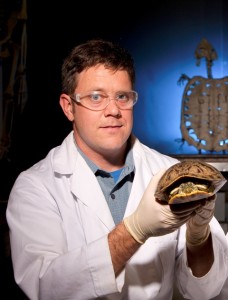As a graduate student, James Dearworth became fascinated by the idea of doing experiments that address how a turtle’s eye and brain work.
He also was inspired by his mentor to provide the kind of guidance that was so pivotal in his own academic development to future students.

Professor James Dearworth
“I hope to inspire Lafayette students to find a passion for something that they will want to do for the rest of their lives,” says Dearworth, associate professor of biology. “Our bread and butter for doing research—our collaborators—are the undergraduates here. We get to take young, talented, and motivated students and shape them into confident citizens that can move to the next level. I want them to develop academic confidence and the ability to become independent learners.”
Dearworth, who often includes student research assistants in his work, uses the common freshwater red-eared slider turtle as an animal model for studying vertebrate vision. A popular pet sold throughout the world (and unfortunately released when owners tire of them), the red-eared slider is among the most invasive species on the planet, endangering native turtle populations. Dearworth concentrates his research on what makes the red-eared slider so adaptable to different environments, specifically the function and anatomy of its visual system.
Biology majors Sze Cheng ’17 (Gurnee, Illinois) and Olivia Erdman ’17 (Wyckoff, New Jersey) are using confocal laser microscopy with Dearworth and electron microscopy with Christopher Anderson, assistant professor of chemical and biomolecular engineering, to identify the location of melanopsin, a photopigment found in all vertebrates including humans, in different tissues of the eye.
“The photopigment is just beginning to be understood as it plays a role in non-image forming processes such as the pupillary light response and circadian rhythm,” explains Dearworth. “We are interested in revealing how melanopsin works in the red-eared slider as its differences compared to other turtle species could possibly be involved in reasons for its success.”
Kofi Boateng ’16 (Bronx, New York), a double major in neuroscience and anthropology & sociology, and Rebecca LaRosa ’15 (Moorestown, New Jersey), a biology major, are working with Dearworth and Megan Rothenberger, assistant professor of biology, to survey turtle populations in the Lehigh Valley. The red-eared slider is native to the Mississippi River Basin.
The team is collecting data to correlate the frequency of different turtle species with the water chemistry of where they are found. Last year, Dearworth used funds from a Delta Upsilon Distinguished Mentoring and Teaching Award to survey turtle populations at the University of Michigan Biological Station. Boateng and LaRosa traveled to the Lacawac Sanctuary in Lake Ariel, Pennsylvania, with Dearworth this summer to collect data. Preliminary data suggest that the red-eared slider’s frequency is greatest in waters that have little oxygen and are more polluted, an interesting finding given that the turtle’s nervous tissue has evolved to survive long-term low oxygen levels.
Cheng, Erdman, and Boateng’s summer work was part of the Science Horizons Program, which provides mentoring for 20 first-year students each year in all aspects of scientific research and is funded by part of the $800,000 grant the College received from the Howard Hughes Medical Institute to prepare students to become leaders in science research and medicine. LaRosa’s work was supported by the David M. Nalven ’88 Summer Research Fellowship. They are all continuing their projects this year.
Neuroscience major Steven Nesbit ’17 (Easton, Pennsylvania) worked with Dearworth over the summer through the EXCEL Scholars undergraduate research program to develop an electrophysiological method to record from the turtle’s optic nerve to determine whether the red-eared slider can detect motion-in-depth stimuli.
The research team, which is continuing its work this year, hypothesizes that the turtle’s retina can detect looming cues that tell the turtle how close an object is and could be responsive to images growing in size on the retinal surface. In humans, it is thought that this type of motion-in-depth processing is done by the cortex, not by optic nerve cells. The red-eared slider’s visual ability could be superior to that of native turtles, providing yet another reason for its extraordinary adaptability.
